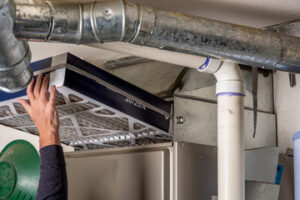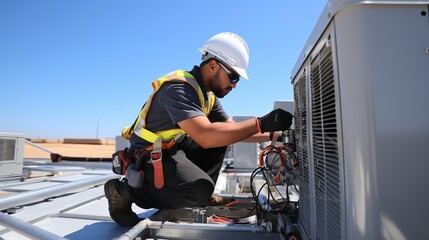Furnace Replacement – Signs That Your Furnace is Nearing the End of Its Lifespan
Furnaces can last up to 15 years with yearly maintenance. If you’re seeing signs that yours is nearing the end of its lifespan, it may be time to consider.
Things to look for include a tripped circuit breaker, a lingering gas odor, or booming noises when the furnace is running. A sudden increase in energy bills can also indicate that it’s time to replace.

Furnaces are one of a home’s largest appliances and one of the most expensive. They also require significant energy to operate, so replacing an old furnace is a smart way to lower your home’s heating costs and improve comfort levels. The cost of a new furnace depends on a number of factors, including the type, size, efficiency rating, and additional features. It’s important to compare prices from multiple contractors and take advantage of any available discounts or incentives. You can also save money by buying a furnace in the off-season or by purchasing a pre-paid maintenance contract with an HVAC company.
The most common types of furnaces are electric, natural gas, and propane. Each has its own advantages and disadvantages, so choose the one that best suits your needs and climate. You may also wish to consider a high-efficiency model that will save you money in the long run by using less fuel.
When shopping for a new furnace, look for a brand with a reputation for quality and durability. Recognized brands usually charge more than unknown or discount manufacturers, but they often offer warranties and better customer service. Additionally, a higher-efficiency furnace will typically cost more upfront, but you’ll save on energy costs over the years.
Depending on the type of furnace you choose and your existing system, the cost of installing it can vary significantly. For example, if you’re switching from an electric to a gas furnace, the contractor will have to install gas lines, which can add $200 to $500 to the total cost. If your home doesn’t have ductwork, it will need to be installed as part of the project, which can increase the cost by $2,000 to $5,000.
You’ll also need to budget for the cost of removing and disposing of your old furnace. This can cost up to $500 depending on the ease of removal, dumping fees in your area, and the distance to the nearest dump site. Your HVAC pro should be able to estimate this cost for you. They will also be able to tell you if your new furnace requires a new circuit panel, which is an extra expense.
As your furnace gets older, it may start to lose efficiency. This can lead to higher energy bills, and it’s often more cost effective to upgrade to a new model. A expert can help you determine if the time to replace your furnace has come. They can help you understand the AFUE rating of your current system and provide you with access to some of the most efficient furnaces in the industry.
You can also reduce your energy bill by upgrading to a variable speed motor. This type of fan runs at a lower speed when it’s not needed, reducing noise and saving energy.
Another way to save energy is to install better insulation in your home. This will keep cold air from leaking into your home and heat from escaping it. A licensed professional can inspect your home’s insulation and make recommendations if necessary.
A professional will also be able to tell you whether your ductwork is in good condition. Older ductwork is more likely to leak air, making it inefficient. Newer ductwork is more efficient, and it will be easier to install.
Once you’ve decided to install a new furnace, it is important to take the time to choose the right one for your needs. This step is crucial, as the wrong furnace could end up costing you more than it’s worth. The best way to avoid this is to have a licensed HVAC professional inspect your existing furnace and provide you with options for replacement.
A new furnace will have a much higher AFUE rating than your old one, which means it will use less fuel to produce the same amount of heat. This will result in lower energy costs and reduced emissions. The energy savings from a new furnace can easily pay for the cost of the installation.
If you are interested in a Furnace Replacement, contact a today to schedule a service. They can help you decide if it’s the right time to replace your existing furnace, and they can help you choose the best model for your home. They can explain the differences between gas and electric models, as well as different size furnaces. They can also recommend other home improvement projects that will improve your furnace’s performance and efficiency.
Furnaces are not cheap appliances to replace, so homeowners want their furnaces to last as long as possible. The lifespan of a furnace can vary based on many factors, but it is usually somewhere between 15 and 20 years. If a furnace is getting close to the end of its lifespan, it should be replaced so that you can save money on your energy bills by switching to a more efficient model.
A few key factors can influence how long your furnace will last, such as the brand you choose and the quality of the installation. Furnaces from trusted manufacturers usually have a longer lifespan, and a professional installation can ensure that the system is correctly sized for your home. Regular maintenance and prompt repair of any problems will also help extend the lifespan of a furnace.
Other important considerations include the location of your furnace and its age. A furnace in a crawlspace, for example, is exposed to outdoor temperatures and pests and will have a shorter lifespan than one located in the garage. Also, a furnace that is older will use more fuel to perform the same job as a newer model, which can lead to higher heating bills.
Regardless of the location or condition of your furnace, you should keep in mind that when the time comes to purchase a new one, it will be worth the investment. Furnaces play a vital role in keeping your home comfortable, and a replacement will make sure that you can enjoy warm winters for years to come.
It is also a good idea to consider the cost of repairs over the lifespan of a furnace. When a repair bill becomes more than half the cost of a new unit, it is generally a better idea to simply replace the existing unit. This will save you the expense of repairing an old, inefficient furnace and will allow you to choose a new model with higher efficiency ratings and lower running costs. Contact us for more information about replacing an old furnace and the benefits of choosing a high-efficiency model.
The furnace in your home is a finely tuned piece of machinery that works to keep you warm and comfortable during the coldest months. It should operate quietly in the background, so any unusual noises could mean that something is wrong. While some furnace sounds may be benign, others can indicate a serious problem that will require Furnace Replacement if not addressed immediately.
If you hear a sound that sounds like metal clanging or scraping together, it’s a sign that your furnace needs maintenance. The issue is most likely with the blower fan or motor, which is rubbing against the casing and other components. This can lead to severe damage if not fixed, so it’s important to turn off your furnace and contact a professional as soon as possible.
A rattling sound is another common complaint that can mean there’s a loose part in your furnace. You can check to see if any panels or doors have come loose and tighten them, but you should also call a professional. A loose part can cause the entire system to overheat and cause more severe issues.
Booming or banging noises are often a sign of a dirty igniter. Dirt on the igniter can cause a delay in ignition, causing gas to build up inside the furnace and eventually create small explosions as it ignites. These explosions can crack the heat exchanger, requiring replacement of the whole furnace. Regular cleaning and inspection of your furnace will help avoid these problems.
Whistling noises can indicate a number of different issues, such as airflow restrictions due to clogged air filters or obstructed vents, or issues with the blower motor bearings. These issues can often be resolved by adding lubrication to the bearings. A squealing sound can be caused by the same issues as a whistling sound, but it can also be a sign that your fan belts are worn out and need to be replaced.
A humming sound can be a sign that your furnace is overheating, which is causing the motor to work harder to keep up with the heating demand. This can also cause your energy bills to go up, so it’s important to get the issue fixed as soon as possible.


